
|
|
ZAMBIA
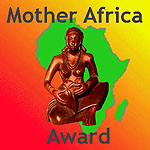
|
|
|
|

|
|
|
Official Name
|
Republic of Zambia
|
|
Located
|
South: DRC, Angola, Mozambique, Zimbabwe
|
|
Capital
|
Lusaka
|
|
Head of State |
President Levy Patrick Mwanawasa, S.C.
|
|
Area
|
752,615 sq km
|
|
Population
|
9.5 million
|
|
Growth rate
|
3.3%
|
|
Official language
|
English
|
|
Currency
|
Zambian kwacha (ZK)
|
|
GNP per capita
|
$350 !!
|
|
Inflation
|
9.8%
|
Airlines
(advertise here)
|
from Europe: Air France
from Asia: ________________
from USA: ________________
|
Hotels
(advertise here)
|
Names & Rates per night
______________________
______________________
|
|
USAfrica Agent
|
______________________
|
|
Country Advertiser
|

|
|
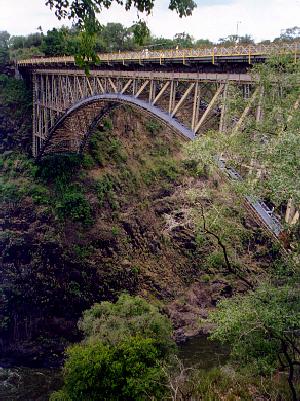
Bridge over the Zambezi River
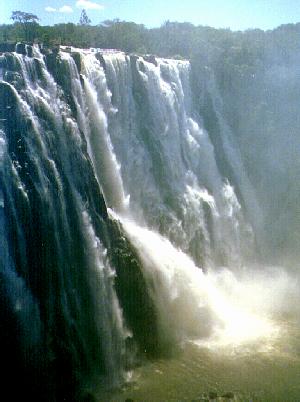
Victoria Falls
|
|
|
For many, Zambia is “the real Africa” with genuinely wild national parks, and some of the finest scenery in the region. For long, Zambia’s Parks have been called southern Africa’s best-kept secret. In the south are the Victoria Falls and the Zambesi River- two of the continent’s major highlights. Lake Tanganyika in the Great Rift Valley is the world’s longest lake, stretching almost 700 km north to south, and the deepest in Africa. It measures over 33’000 sq km with a total shoreline of 3’000 km. THE VICTORIA FALLS Known to Africans as Mosi-Oa-Tunya or "the smoke that thunders", the falls are majestic in their splendor as they tumble in curtains of water to the gorge below. The Zambezi River is nearly 1.6 kilometers (1 mile) wide at this point and plunges 100 meters (320 feet) over the cliffs. Five separate falls make up the Victoria falls: Devil's Cataract, Main Falls, Horseshoe Falls, Rainbow Falls and Eastern Cataract. When the Zambezi is at its height, the water races over its edge at speeds in excess of 160 kilometers per hour (100 miles per hour). "Scenes so lovely must have been gazed upon by angels in their flight." So exclaimed the first European missionary-visitor Dr David Livingstone in 1855.

|
|
Lusaka:
Lusaka is the capital of Zambia. Around 1890, the British South Africa Company appropriated this area. The British Colonial Office controlled this area from 1924. In 1935, Lusaka was named the capital of Northern Rhodesia. The Federation of African Societies set the Northern Rhodesian Congress up here in 1948. Lusaka was at the center of the civil disobedience movement, which ultimately created the independent state of Zambia. Lusaka became the capital of this state. Today, Lusaka has a mixed economy, which incorporates agriculture as well as textiles, manufacturing, and so on. Farming is an important economic activity, as is the raising of livestock. The city has the University of Zambia an international airport at it's outskirts. Major ethnic groups include the Nyanja and Soli. Europeans and Asians are the minorities.
Economy:
Zambia’s economy is heavily dependent on the mining of copper, cobalt, and zinc. Copper and other metal exports account for about 75 percent of the country's export earnings. A collapse in copper prices, oil price shocks, and statist economic policies in the early 1970s had a devastating effect on Zambian economy. This has been compounded by a continual contraction, since independence, of Zambia's food production—turning the country into a food-deficit nation. The resulting economic decline has been catastrophic, with per capita income falling almost 5 percent annually between 1974 and 1990. The Government’s economic reform program recognizes that Zambia’s future lies in diversifying and expanding its economic base and by increasing agricultural production. Since 1992, President Chiluba’s government has initiated a series of ambitious market-oriented economic reforms aimed at reducing state participation in and control of economic activity. Prices have been decontrolled and subsidies eliminated; the exchange rate and interest rates are now market determined; quantitative restrictions on imports have been eliminated; import tariffs have been reduced and their structure simplified; parastatal monopolies have been ended; and crop marketing has been liberalized. The economy recovered in 1999, aided by good weather and a relatively stable exchange rate.
PricewaterhouseCoopers: Serving you in Zambia
History:
Zambia attained independence from Britain in 1964. Kenneth Kaunda became the country’s first president and proclaimed one-party rule. Opposition parties were legalized in 1990. In a subsequent election in 1991, Fredrick Chiluba the leader of the Movement for Multiparty Democracy (MMD) defeated Mr. Kaunda. Mr. Chiluba was re-elected in 1996. Next Presidential elections are scheduled for fall 2001. Recently, Zambia has been playing an important role as a mediator in the conflicts in the Central African region.
|
|
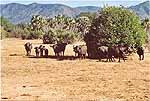
Buffalos
©2002: Boudewijn
Hoogeweegen
|
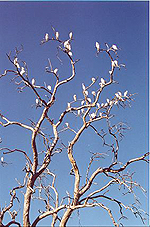
Cattle Egerts
©2002: Boudewijn
Hoogeweegen
|
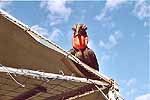
Momba the Groundhorn Bill
©2002: Boudewijn
Hoogeweegen
|

Lilacbreast Droller
©2002: Boudewijn
Hoogeweegen
|
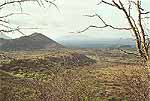
Tsavo hills
©2002: Boudewijn
Hoogeweegen
|
|
Transfrontier Park:
The area surrounding the Okavango-, Kwando- and Zambezi Rivers, has been described as the "Eden of Africa" as long ago as in the beginning of the previous century. Since then very little and very much has changed. Much has changed in this sense that the areas has been carved up into 5 different countries and has experienced the scourges of war. Little has changed in this sense that hardly any development has taken place and the border is often just a line drawn on a map - still peoples and wildlife co-exist in harmony and trek across borders at will.
This amazing area varies from the "Thirstland" of the Kalahari Desert, to the amazing Okavango Swamps and the tropical paradise around the world famous Victoria Falls. Large sections of this area has never been fully explored but more than 500 species of birds have been listed. The animal kingdom is truly remarkable with Sable antelope, Roan antelope, elephant, buffalo, hippopotamus and crocodile in abundance.
Read the full story CLICK HERE
The Mighty Zambesi:
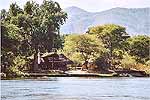
Zambesi Camp Chiawa
©2002: Boudewijn
Hoogeweegen
|
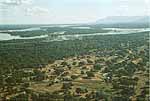
Zambesi River
©2002: Boudewijn
Hoogeweegen
|
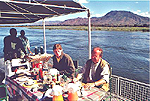
Breakfast at the Zambesi
©2002: Boudewijn
Hoogeweegen
|
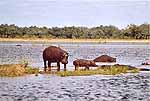
Hypos
©2002: Boudewijn
Hoogeweegen
|
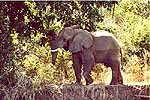
Big Boy
©2002: Boudewijn
Hoogeweegen
|
Livingstone:
In the 1930’s Livingstone was the capital of Northern Rhodesia. The colonial style architecture and Jacaranda –lined streets remain to provide a historic and color view. Livingstone has a lot of historical places within almost walking distances, the tourist capital offers a lot of outdoor adventure and these are variety activities, which
makes most scenic regions of Zambia. Some of the places to visit are the local crafts markets at the Victoria Falls and Mukuni Park situated just the at the end of airport road. The Old Maramba Market, The Livingstone Museum, Railways Museum, Mukuni
Village, Nanoos Shop, LF More Chemist, the North Western Mansions where the old
railway station used to be, and archeological sites along the mighty Zambezi river.
As earlier stated the tourist capital has a spectacular Victoria Falls are only 10 kms from the town. The falls are one of the Seven Natural Wonders of the world.
Enabling us to improve the quality of the content, if you have additonal information, remarks or suggestions, please share it with us by e-mail.
|
LUSAKA, 2 January 2002: Despite the polls’ multiple flaws, Patrick Levy Mwanawasa’s election as Zambia’s president, put the country at the cutting edge of Africa’s democratic development. With Mwanawasa’s election, Zambia has become the third country in sub-Saharan Africa to have three consecutive, democratically elected heads of state since independence. His Excellency, President Levy Patrick Mwanawasa, S.C., was born on 3rd September, 1948, in Mufulira, Zambia.
LUSAKA, 6 October 2001: Zambian President Frederick Chiluba called Saturday for a peaceful campaign ahead of presidential and parliamentary elections due before the end of the year, state radio reported. Chiluba spoke shortly after he led scores of ruling party members to inspect the voters' roll in Ndola, a town in the country's Copperbelt province. He urged people to vote for Levy Mwanawasa, the presidential candidate for the ruling Movement for Multiparty Democracy, the radio said. Chiluba is due to set a date for the vote after October 20 once the Electoral Commission of Zambia (ECZ) has completed
preparations. "Our report to the president will only be ready on October 20th," a senior election official. "The President will then be at liberty to announce the date of
the elections," the official said. Chiluba will retire as president this year after serving two five-year terms.
LUSAKA, 5 October 2001: Zambia's economy is expected to grow five percent in 2001, marking the first time in many years that the government will achieve its target, finance minister Katele Kalumba said Friday. "Economic performance in the year through September 2001 has been favourable," Kalumba told reporters at a news briefing. "Available information indicates that government is on course in realising its macro-economic objectives set for 2001 of achieving a five percent growth," Kalumba said. The growth in Zambia's gross domestic product has been powered by strong performances in agriculture, mining, construction and tourism sectors, he said. Kalumba said the major challenge that his government faces in the last quarter of the year is maintaining low inflation, whose
stability is threatened by impending grain imports. "The year-to-date inflation as at September was 9.8 percent, while 12 month inflation was at 17.4 percent," Kalumba said, calling Zambia's economic performance this year a success story. Kalumba also announced that Zambia has increased tariffs on imports of refined fuel products from five percent to 25 percent, in a bid to encourage the local processing of crude oil. "We want supplies to process the oil locally," Kalumba said. When crude oil is locally refined, the by-products are also used in the production of lime and for running the machinery in the
mines.
LUSAKA, 5 October 2001: Zambia's government has sold off 251 state-owned companies out of the 280 targetted for privatisation, Finance Minister Katele Kalumba said.
"Since the privatisation programme started, over 251 companies or units have been privatised by end of August 2001," Kalumba said at a news briefing. That figure includes a big chunk of Zambia's copper mines, which were sold to foreign investors. "Government continues to be fully committed to the privatisation programme," Kalumba said, adding that Zambia's sole railway company would be privatised by June 2002. A study on privatising the monopolistic state-run electricty supply company, Zambia Electricity Supply Corporation (ZESCO) has been completed. "The privatisation of ZANACO, a state-owned commercial bank is also progressing well," Kalumba said. Zambia embarked on a privatisation drive of state-owned companies in 1992, a year after President Frederick Chiluba took office. He replaced liberation leader Kenneth Kaunda, who had a socialist-oriented government.
LUSAKA, 18 Sept 18 2001: About 250 pigs have died from a mysterious disease that has hit parts of the Southern Province of Zambia, a veterinary officer said Tuesday.
The disease broke out three weeks ago a veterinary officer, Panel Nyimba told state radio. People in the affected areas have been advised to stop eating pork since veterinary officers do not yet know the cause of the disease, or its effects Nyimba was quoted as saying. Farmers have also been advised to lock up all their animals
until further notice, the radio added.
The Holiday Inn in Lusaka is a typical Holiday Inn (clean sheets, TV, restaurant, Western mod-cons etc), at $120 for a single. The Internet Café alongside the parking lot of the Holiday Inn is really great, with quiet atmosphere, free tea and coffee, and friendly service. (Marc Lurie)
Last update: 27 July, 2009
|
|











